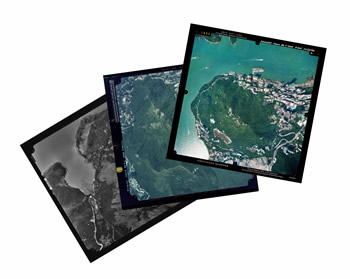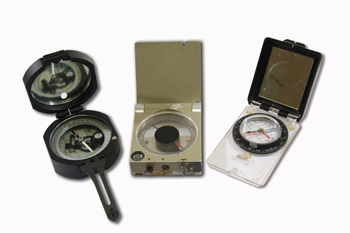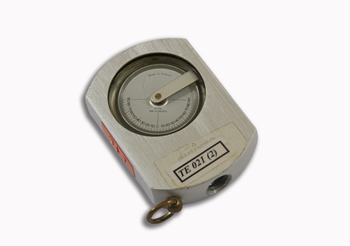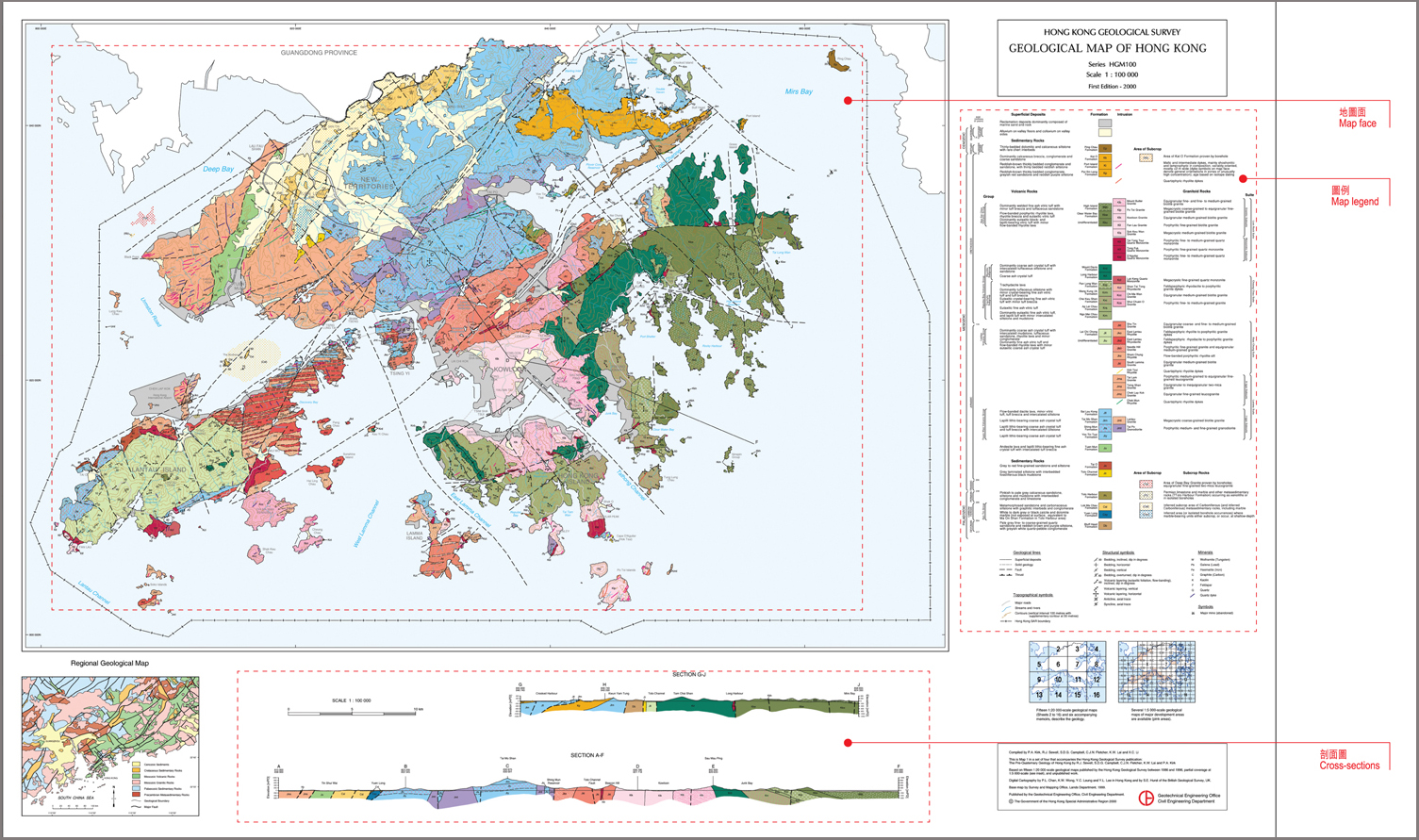In simple terms, a geological map shows the surface distribution of rocks in a particular area. However, in order to fully understand a geological map, it is necessary to be familiar with several basic geological principles, including the laws of stratigraphy, geological age, and geological structures. To the experienced eye, a geological map reflects the three-dimensional distribution of rocks, and also serves as a visual guide to the geological history of the area.
Principles of Stratigraphy
Sediments (mineral grains and fragments of rock) are produced by weathering at the Earth's surface. They are removed by erosion and deposited elsewhere as layers, which thicken over time and, as the weight and pressure increases, they are eventually compressed and lithified to form sedimentary rock.
The father of modern geology was James Hutton, an eighteenth century scientist. After observing modern rates of sediment accumulation, Hutton concluded that long periods of time were required to build up the thick layers of sedimentary rock strata seen today. Hutton also concluded that geological processes similar to those today must have operated in the past. This led to the theory of Uniformitarianism, which states that all ancient rocks and geological features can be explained by observing the operation of modern-day processes. Uniformitarianism is usually referred to by the more explanatory phrase "the present is the key to the past".
The study of rock layers preserved in the geological record is called stratigraphy (Figure 1).
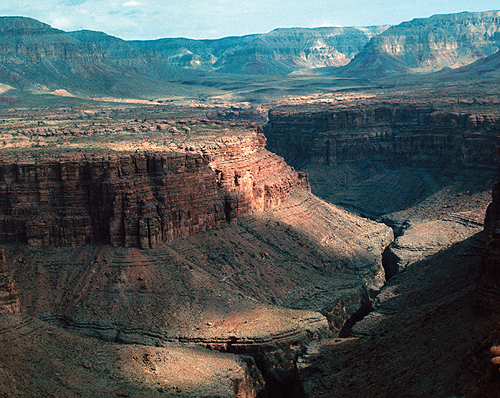
Figure 1: Late Palaeozoic layered sedimentary rocks (strata) exposed in Grand Canyon National Park, the U.S.A. (photo by courtesy of US Geological Survey).
Stratigraphy is based on two underlying principles:
- The Law of Superposition was introduced by Nicolas Steno in 1699, after recognizing that successive beds of sediments laid down in horizontal layers have the oldest beds at the base, and the youngest beds at the top, forming a stratigraphical sequence.
- The Law of Fossil Assemblages was introduced by William Smith, a mining geologist in England. Smith observed that, in any one area, the individual rock layers, or strata, were arranged in a predictable pattern. Importantly, groups of strata containing similar types of fossils (fossil assemblages) always occurred in the same relative stratigraphical (age) position. This fact enables groups of strata in different areas to be correlated, and allowed Smith to produce the first national geological map in 1815.
The two principles of stratigraphy allow the relative age of rocks in a stratigraphical sequence to be determined. Relative age refers to whether a rock layer in a sequence is older (or younger) than other layers in the sequence. There is, however, no implication of the true age (i.e. absolute age) of the rock.
Relative Age
Consider Figure 2. According to the Law of Superposition, the sediments of sandstone, siltstone, mudstone, limestone, volcanic ash and conglomerate were deposited in a sequence. Sandstone is the oldest rock, and conglomerate is the youngest.
Two other principles enable the relative age of rocks and geological events to be inferred, namely:
- The Principle of Cross-cutting Relationships, which states that any geological feature (such as a dyke) that cuts across an existing rock unit must be younger than that unit.
- The Principle of Included Fragments, which states that any rock containing fragments of another rock body must be younger than the rock body from which the included fragments are derived.

Figure 2: Relative age relationship of sedimentary and igneous rocks.

Table 1: The sequence of geological events shown in Figure 2.
In Figure 2, because fragments of mudstone are found within the granite body (The Principle of Included Fragments), the granite intrusion must be younger than (post-date) the formation of limestone and mudstone. Furthermore, the dyke cuts across the layers of sandstone, siltstone, mudstone, limestone and volcanic ash, and also the granite body, but not the conglomerate. This relationship confirms that the intrusion of the dyke post-dated the formation of sandstone, siltstone, mudstone, limestone, volcanic ash and granite, but pre-dated the deposition of conglomerate. Finally, a normal fault has displaced the rock sequence so that the right hand side has been downthrown.
Therefore, a brief history of the geological events shown in Figure 2 can be summarised as Table 1.
It is very important to be aware that the rock layers observed in a particular stratigraphical sequence may not be a complete record of the history of deposition. Some sediments or rock layers within the sequence may have been weathered and partly removed by erosion. There may have been long periods with no deposition. There may even be other rock layers that have been completely removed by erosion, with the result that an entire period of the geological history of the area is missing. In fact, more geological events are probably missing from the geological record than are recorded by the surviving rock sequences.
Having established the geological history of a particular locality from the stratigraphical relationships, the relative ages of the different sedimentary rock layers can be determined by examining the fossil content. Rock sequences that are separated by long distances can then be correlated by applying the Law of Fossil Assemblages, even though the fossils may not occur in the same rock type due to changes in sedimentary environment across an ancient ocean or landmass.
Geological Time Scale
A geological map shows the surface distribution of different rock types, their structural features, and their age relationships.
The first geological maps simply showed the relative stratigraphical positions of groups of rocks that contained similar fossil assemblages. Over time, as more areas were mapped and knowledge increased, the geological time-scale was developed, based on a wide range of rock and fossil occurrences. Geological Time Units were subsequently devised, which placed particular groups of rocks and fossils into relative age categories. Many of these time units are named after groups of strata that were first described from type localities in the British countryside (e.g. the Devonian).
The last 542 million years to the present is known as the Phanerozoic (meaning "life presence") era. It contains the most subdivisions in the geological time scale because this period in Earth history was teeming with recognisable and evolving plant and animal life. The boundaries between geological time units of the Phanerozoic era are marked by widespread extinctions in the fossil record and by major unconformities in the rock sequence that signify global events, such as major magmatic episodes and meteorite impacts events. Examples include the voluminous global outpourings of magma at the end of the Permian and Cretaceous periods, and a meteorite impact at the end of the Cretaceous.
Until the beginning of the twentieth century, there were no scientific methods available for determining the true (absolute) age of rocks. Thus, the Geological Time Units represented only relative ages. Over the years, various theories had been proposed for the age of the Earth. Theological estimates suggested that the Earth was very young, but even the early geologists recognised that long periods of time were required to accumulate the vast thicknesses of sedimentary rocks. Based on estimates of the time needed for the exterior of the Earth to cool from a molten state, the British physicist Lord Kelvin calculated, in 1846, that the Earth was about 20 to 30 million years old.
In the early twentieth century, it was recognized that the natural radioactivity inherent in rocks could be used to date rocks in the geological record. This development enabled ages to be assigned to the Geological Time Units, and led to the establishment of the Geological Time Scale (Figure 3), a framework that is still being refined as age-dating techniques are developed and improved.
The first geological time scale was proposed in 1913 by Arthur Holmes (1890 - 1965), a British geologist. Periodically, as new data becomes available, the ages of the boundaries between geological time units are revised by the International Commission on Stratigraphy, and ratified by the International Union of Geological Sciences. The latest revision was completed and promulgated in 2008.
Absolute Age
Radioactive isotopes ("the clocks in rocks") are used to determine the absolute (or numerical) age of a rock. The absolute age of a rock is calculated as a specific number of years.
In simple terms, isotopes of an element exist when the same element has a different number of neutrons in the nucleus, but the same number of electrons and protons. Some of these isotopes (the parent isotope) are unstable (i.e. radioactive), and decay to a more stable isotope (the daughter isotope) by releasing energy. The rate of decay from parent to daughter isotope is constant, and is unique for each particular isotope.
Many minerals contain radioactive isotopes. Once a mineral is formed, the parent isotope in the mineral begins to decay to produce a daughter isotope. In theory, the age (time since formation) of these minerals, and thus the age of the rock bearing them, can be determined by counting the ratio of parent to daughter isotopes in the mineral. The age of the mineral is the length of time that is required to produce the quantity of daughter isotope that has accumulated in the mineral. This length of time required can be calculated using the known decay rate for the isotope.
Age of the Earth
It is now known that the oldest dated rocks on the Earth are about 4.28 billion years old. However, since these original rocks have been recycled and destroyed during the process of plate tectonic movements, they do not provide a reliable age for the Earth. Instead, the most reliable estimate of the age of the Earth is based on the radiometric dating of meteorites. Meteorites are believed to be material left over from the formation of the Solar System. The age of the oldest minerals contained in iron meteorites that have entered the earth's atmosphere is about 4.57 billion years, which is currently regarded as being the best estimate for the age of the Earth.

Figure 3: A simplified Geological Time Scale.
Geological Map
Geological maps are a visual representation of a wide variety of geological data, including the distribution of rocks and sediments in a particular area, the types of rocks, their age relationships, and the structural features in that area.
A geological map normally comprises a topographical base map, overlain by areas of colour, to show the distribution of stratigraphical units (rocks and sediments), and special symbols, to show structural and other geological information. Geological maps include a legend that explains the meaning of the symbols, the ages of the stratigraphical units, and provides a key to the units. In some cases, the geological legend may also show stratigraphical relationships. To assist the user with an interpretation of the geology, geological maps usually include one or more representative cross-sections (Figure 4).
Geological maps are used for a wide variety of purposes including land use planning, natural hazard assessments, mineral resource investigations, water resources evaluations, and engineering construction projects.
A geological map is a summary document from which the geological history of an area can be deciphered. However, it should be realised that a geological map is an interpretation, by a geologist, of the geological facts that were available at the time that the map was prepared. The accuracy of a geological map is largely a function of the time spent walking over the area, and time available for data collection. Geological maps can be revised and improved as more field work is carried out, and as more data from boreholes and excavations becomes available.
Groups, Formations and Suites
A stratigraphical unit is a discrete stratum or body of rock that occurs as a definable and mappable feature. Stratigraphical units with distinctive lithological, physical and chemical characteristics are shown as formations on geological maps. Two or more geographically associated formations with similar characteristics may be assigned to a group, which is the next order above a formation.
Large, single intrusive units are shown on geological maps as plutons or granite bodies, named after the particular geographical locality in which they occur. The stratigraphical status of these features is equivalent to a formation. Closely associated plutons or granite bodies with a characteristic chemistry and mineralogy are grouped as suites.
In Hong Kong, the volcanic formations are commonly assigned to a group that represents a particular magmatic episode, a phase or period of volcanic activity. Suites are the plutonic (intrusive) equivalent of volcanic (extrusive) groups, and represent a particular magmatic episode. The unconsolidated superficial sediments are the youngest stratigraphical units, which form a cover over most of the solid (consolidated) bedrock. In Hong Kong, superficial deposits comprise alluvium (river deposits) and colluvium (hillslope deposits) onshore, and marine mud, sand, and Pleistocene alluvium offshore.
What is shown on a Geological Map?
Coloured Areas
A unique colour is assigned to each stratigraphical unit (but not to each lithological type) on a geological map. The selection of colours usually depends on the age of the stratigraphical units, with several internationally recognised colour schemes adopted for specific stratigraphical units and geological periods. However, to a greater or lesser extent, almost all geological maps depart from the standard colour schemes, depending upon the specific purposes of the map.
In addition to a unique colour, a letter symbol is commonly used to identify the stratigraphical unit in a particular area. The first letter, a capital, usually refers to the geological age of the unit. For example, J designates the Jurassic (about 200 to 145 million years ago), P the Permian (about 299 to 251 million years ago), and D the Devonian (about 416 to 359 million years ago). Subsequent (lower case) letters identify the formation name or the principle lithological type.
Geological Lines
The type of contact between different rock units is a critical factor to observe on a geological map. There are three main types of geological contact: an intrusive contact, a depositional contact, and a fault contact. On geological maps, intrusive and depositional contacts are generally shown by fine lines, whereas a fault contact is represented by a heavy line.
Not all the faults shown on a geological map are active (i.e. earthquake-related) at present. Rocks can preserve a record of faults that have been inactive for a very long period. Thus, the fault lines shown on a geological map simply represent the traces (locations) of faults that are preserved in the rocks.
Geological boundaries are shown as either solid or dashed lines on a geological map. This reflects the degree of certainty, and hence accuracy, of the geological contact represented on the map. Usually, in the field, geological contacts are obscured by vegetation, soil, or urban construction. Wherever a geological boundary is observable, it is shown as a solid line on the map, but where a boundary is uncertain, or is inferred, the line is dashed. Generally, the shorter the dash, the more uncertain is the location of the boundary.
The lines on a geological map may be modified using symbols (for example, filled triangles, small tick marks, arrows, etc.). These symbols provide additional information about the nature of the geological line. For example, faults (heavy lines) with triangle symbols show that the fault is a thrust fault, and that the side of the line with the triangles has been pushed over the side without the triangles. Other line symbols are explained on the map legend.
Geological Symbols
Strike and dip symbols provide information about the three-dimensional orientation of geological surfaces such as bedding, joints, faults or foliations (Figure 5). Using a compass and clinometer, geologists measure the orientation of these structures wherever they can find suitable solid rock exposures (as opposed to loose boulders). The orientation and angle are recorded as a strike and a dip respectively. Each dip and strike symbol on a geological map usually represents the average of several measurements.

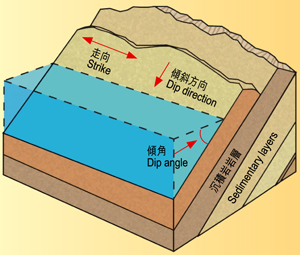
- Strike: The strike of an inclined geological plane is the direction of an imaginary horizontal line projected across the surface (Figure 6). Strike may be visualised by immersing a sheet of glass into a bowl of water. Because the water surface is horizontal, the waterline on the glass is a horizontal line, or a strike line. The direction (azimuth) of the waterline is the strike.
- Dip: Dip generally refers to the dip angle, which is the angle between a geological plane and the horizontal, i.e. the angle at which the plane slopes downwards, as measured in the dip direction. The dip direction is always perpendicular to the strike, and is the direction of maximum slope of an inclined plane. Thus, an horizontal plane has dip of 0°, and a vertical plane has a dip of 90°.
Map Legends
An important component of geological maps is the legend (or key), on which examples of all the colours, lines and symbols are reproduced and explained. A legend is necessary for a full understanding of a geological map. The legend itemises the colour and the letter symbol of each stratigraphical unit as a column, with the youngest, or most recently formed, units (e.g. the man-made deposits) at the top, and the oldest units in the area at the bottom. The name of the stratigraphical unit, a short description of the types of rocks or sediments present, and their age, are also included. Legends also explain the types of geological lines used, the strike and dip symbols, and the other kinds of geological symbols shown. These may include mineral occurrences, fossil locations, and other geological features that might be important in the area.
Geological Mapping Tools
Traditionally, geological maps are made by geologists who walk over as much of the map area as possible, noting where rocks can be seen (outcrops), the rock types (lithology), their structure, degree of weathering, and any other features that might be useful. All observations are marked upon a topographical base map, and measurements are taken using a magnetic compass and clinometer. Aerial photographs may help the geologist to identify target features in the field.
- Topographical base maps show the landscape of an area in the form of contours (lines of equal height), rivers, lakes, reservoirs, roads, buildings, footpaths, etc. Topographical maps are drawn at various scales, the most common scales in Hong Kong being 1:20,000 and 1:5,000, with 1:1,000 scale maps also available. This means, for example, that on a 1:10,000 scale map, 1 centimetre on the map represents 10,000 centimetres (100 metres) on the ground. The scale of the topographical base map selected depends upon the survey objectives, i.e. the amount of geological detail required on the finished map.
- Aerial photographs (Figure 7) are taken from aircraft flying at fixed heights above the ground. Adjacent pairs of aerial photographs with about 60% overlap can be used under a stereoscope to provide a three-dimensional image of the landscape, which is useful for reconnaissance surveys. The scale of the aerial photograph can be determined if the flying height and the focal length of the camera lens are known. Aerial photographs of limited areas of Hong Kong are available for some years between 1924 and 1963. Systematic, annual, territory-wide black and white aerial photographic coverage began in 1963, twice-annual black and white photography began in 1985, and routine, twice-annual colour photography began in 1993.
- Magnetic compasses (Figure 8) are instruments used to determine the direction of the magnetic north pole. They work on the principle that the molten core of the earth causes the earth to act like a giant magnet, with the ends (positive and negative poles) of the magnet located in the vicinity of the north and south geographical poles. A magnetic compass, which has a magnetised needle that pivots freely over a 360 degree graduated dial, is used to determine the direction of the north pole from the position of the observer. However, the magnetic north pole migrates up to about 1,167 kilometres from the geographical north pole, a value that varies annually. In Hong Kong, the magnetic north pole and the geographical north pole are in the same relative direction. In other parts of the world, this difference must be compensated for by adding, or subtracting, an angle of up to about 30 degree (the magnetic declination) from the compass reading.
- Clinometers (Figure 9) are used to measure the angle of inclination of a surface, such as the angle of dip of rock strata. They employ a spirit level (a bubble of air in a liquid enclosed in a glass tube) or a pendulum to determine the horizontal and vertical inclination respectively. Clinometers are equipped with graduated half circles from which the angle of dip of a surface from the horizontal can be read.
